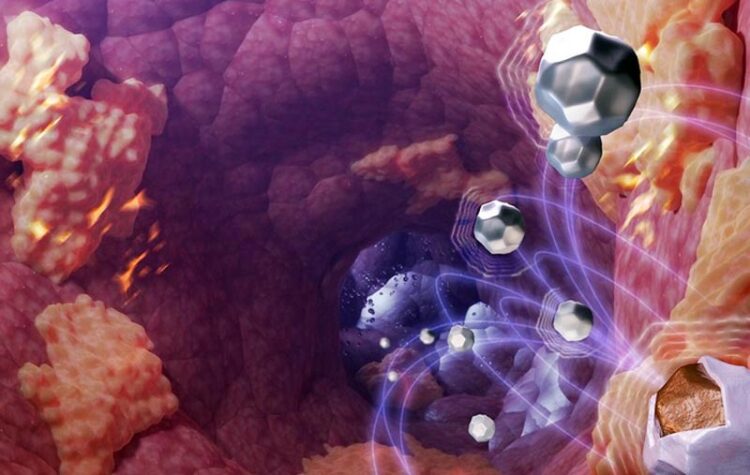New, heat-efficient nanoparticles for treating cancer

Nanoparticles accumulate in tumor.
Credit: Olena Taratula, Oleh Taratula, OSU College of Pharmacy
Oregon State University scientists have invented a way to make magnetic nanoparticles that get hotter than any previous nanoparticle, improving their cancer fighting ability.
Faculty from the OSU College of Pharmacy spearheaded a collaboration that developed an advanced thermal decomposition method for producing nanoparticles able to reach temperatures in cancer lesions of up to 50 degrees Celsius, or 122 degrees Fahrenheit, when exposed to an alternating magnetic field.
Findings of the preclinical study led by Oleh Taratula and Olena Taratula were published today in the journal Small Methods.
Magnetic nanoparticles have shown anti-cancer potential for years, the scientists said. Once inside a tumor, the particles – tiny pieces of matter as small as one-billionth of a meter – are exposed to an alternating magnetic field. Exposure to the field, a non-invasive process, causes the nanoparticles to heat up, weakening or destroying the cancer cells.
“Magnetic hyperthermia shows great promise for the treatment of many types of cancer,” Olena Taratula said. “Many preclinical and clinical studies have demonstrated its potential to either kill cancer cells directly or enhance their susceptibility to radiation and chemotherapy.”
But at present, magnetic hypothermia can only be used for patients whose tumors are accessible by a hypodermic needle, Oleh Taratula said, and not for people with hard to reach malignancies such as metastatic ovarian cancer.
“With currently available magnetic nanoparticles, the required therapeutic temperatures – above 44 degrees Celsius – can only be achieved by direct injection into the tumor,” he said. “The nanoparticles have only moderate heating efficiency, which means you need a high concentration of them in the tumor to generate enough heat. And numerous studies have shown that only a small percentage of systemically injected nanoparticles accumulate in tumors, making it a challenge to get that high concentration.”
To tackle those problems, the scientists developed a new chemical manufacturing technique that resulted in magnetic nanoparticles with more heating efficiency. They demonstrated in a mouse model that the cobalt-doped nanoparticles will accumulate in metastatic ovarian cancer tumors following low-dose systemic administration, and that when exposed to an alternating magnetic field, the particles can rise in temperature to 50 degrees Celsius.
“To our knowledge, this is the first time it’s been shown that magnetic nanoparticles injected intravenously at a clinically recommended dose are capable of increasing the temperature of cancer tissue above 44 degrees Celsius,” Olena Taratula said. “And we also demonstrated that our novel method could be used for the synthesis of various core-shell nanoparticles. It could serve as a foundation for the development of novel nanoparticles with high heating performance, further advancing systemic magnetic hyperthermia for treating cancer.”
Core-shell nanoparticles have an inner core structure and an outer shell made from different components, she said. Researchers are especially interested in them because of the unique properties that can result from the combination of core and shell material, geometry and design.
In addition to Olena and Oleh Taratula, the collaboration also included College of Pharmacy researchers Youngrong Park, Abraham Moses, Peter Do, Ananiya Demessie, Tetiana Korzun, Fahad Sabei, Conroy Sun, Prem Singh, Fahad Sabei and Hassan Albarqi, as well as Pallavi Dhagat from the Oregon State College of Engineering and researchers from Oregon Health & Science University.
The National Cancer Institute, the Eunice Kennedy Shriver National Institute of Child Health and Human Development and the OSU Advantage Accelerator Innovation Development program funded this research.
Journal: Small Methods
DOI: 10.1002/smtd.202200916
Method of Research: Experimental study
Subject of Research: Animals
Article Title: An advanced thermal decomposition method to produce magnetic nanoparticles with ultrahigh heating efficiency for systemic magnetic hyperthermia
Article Publication Date: 1-Nov-2022
COI Statement: The authors declare no conflict of interest.
All latest news from the category: Life Sciences and Chemistry
Articles and reports from the Life Sciences and chemistry area deal with applied and basic research into modern biology, chemistry and human medicine.
Valuable information can be found on a range of life sciences fields including bacteriology, biochemistry, bionics, bioinformatics, biophysics, biotechnology, genetics, geobotany, human biology, marine biology, microbiology, molecular biology, cellular biology, zoology, bioinorganic chemistry, microchemistry and environmental chemistry.
Newest articles

High-energy-density aqueous battery based on halogen multi-electron transfer
Traditional non-aqueous lithium-ion batteries have a high energy density, but their safety is compromised due to the flammable organic electrolytes they utilize. Aqueous batteries use water as the solvent for…

First-ever combined heart pump and pig kidney transplant
…gives new hope to patient with terminal illness. Surgeons at NYU Langone Health performed the first-ever combined mechanical heart pump and gene-edited pig kidney transplant surgery in a 54-year-old woman…

Biophysics: Testing how well biomarkers work
LMU researchers have developed a method to determine how reliably target proteins can be labeled using super-resolution fluorescence microscopy. Modern microscopy techniques make it possible to examine the inner workings…





















